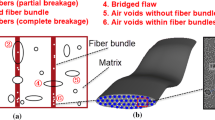Abstract
Applying the fundamental definition of thermal conductivity to a unit cell of unidirectional fiber reinforced composite with air voids, one can deduce simple empirical formula to predict the thermal conductivity of the composite material with estimated air void volume percent. The inherent 3-D problem is modeled using finite element analysis. The model is tested at different fiber to resin volume ratios and various fibers to resin thermal conductivity ratios for three different air void volume percent. The air voids are modeled as cylindrical shapes with different lengths aligned with fiber direction. Two prediction schemes have been developed through the present work. One is to predict the longitudinal thermal conductivity and the other is to predict the transverse thermal conductivity of the fibers. Also, the model can be used to estimate the voids volume percent if the fiber thermal conductivity has been provided. Such expression can, also, serve as useful guides for quality and perfect bonding for material development.




Similar content being viewed by others
Abbreviations
- a i :
-
constants, i=1,2,3,..
- A :
-
wall area (m2)
- b i :
-
constants, i=1,2,3,..
- f i :
-
constants, i=1,2,3,..
- h i :
-
constants, i=1,2,3,..
- \( \widehat{h} \) :
-
heat transfer coefficient (J/(sec m2 C°))
- K c :
-
equivalent thermal conductivity of the composite (J/m s K°)
- K r :
-
thermal conductivity of the resin (J/m s K°)
- K f :
-
hermal conductivity of the fiber (J/m s K°)
- K cr :
-
composite to resin thermal conductivity ratio
- K fr :
-
fiber to resin thermal conductivity ratio
- L :
-
distance between two opposite walls (m)
- q :
-
heat flux (J)
- T conv :
-
convective wall temperature (K°)
- T w :
-
wall temperature (K°)
- T ∞ :
-
bulk temperature of the fluid at convective side (K°)
- vair:
-
void volume percent in the composite
- V r :
-
resin volume percent
- V f :
-
fiber volume percent
- V fr :
-
fiber to resin volume ratio
References
Dasgupta A, Agarwal R (1992) Orthotropic thermal conductivity of plain-weave fabric composites. J Composite Mater 26(18):2736–2758
Thomas L, Antar M (1998) Heat transfer in composite walls: a practical two-dimensional thermal circuit method. ASHRAE Trans 104(2):198–209
Tai H (1996) Equivalent thermal conductivity of two- and three-dimensional orthogonally fiber-reinforced composites in one-dimensional heat flow. J Composites Technol Res JCTRER 18(3):221–227
Zou M, Yu B, Zhang D (2002) An analytical solution for transverse thermal conductivities of unidirectional fiber composites with thermal barrier. J Phys D Appl Phys 35(15):1867–1874
Shim H, Seo M, Park S (2002) Thermal conductivity and mechanical properties of various cross-section types carbon fiber-reinforced composite. J Mater Sci 35(9):1881–1885
Terron JM, SanchezLavega A (2002) On the effective thermal diffusivity of fiber-reinforced composites. Appl Phys Lett 80(11):1903–1905
Graham S, McDowell D (2003) Numerical analysis of the transverse thermal conductivity of composites with imperfect interfaces. J Heat Transf 125:389–393
Jones FW, Pascal F (1995) Numerical calculation of the thermal conductivities of composites—a 3-D model. Geophysics 60:1038–1050
Krach A, Advani SG (1996) Influence of void shape, void volume and matrix anisotropy on effective thermal conductivity of a three-phase composite. J Composite Mater 30(8):933–946
Wang CY (1999) Thermal conductivity of a material containing a layer of thin strips or a staggered array of thin strips. J Heat Transf 121(1):174–177
Xin-Gang L, Xu J (2000) Thermal conductance of randomly oriented composites of thin layers. Int J Heat Mass Transf 43(19):3633–3640
Islam MR, Pramila A (1999) Thermal conductivity of fiber reinforced composite by FEM. J Composite Mater 33(18):1699–1715
Nan CLiX, Birringer R (2000) Inverse problem for composites with imperfection interface: determination of interfacial thermal resistance, thermal conductivity of constituents, and micro-structural parameters. J Am Ceram Soc 83(4):848–854
Al-Sulaiman FA, Mokheimer EM, Al-Nassar YN (2006) Prediction of the thermal conductivity of the constituents of fiber reinforced composite laminates. Heat Mass Transf 42(5):370–377
Author information
Authors and Affiliations
Corresponding author
Rights and permissions
About this article
Cite this article
Al-Nassar, Y.N. Prediction of thermal conductivity of air voided-fiber-reinforced composite laminates part II: 3D simulation. Heat Mass Transfer 43, 117–122 (2006). https://doi.org/10.1007/s00231-006-0099-5
Received:
Accepted:
Published:
Issue Date:
DOI: https://doi.org/10.1007/s00231-006-0099-5




